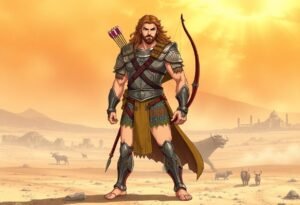Adam, the first man created by God, is a foundational figure in the Bible, representing both the beginning of human life and the origin of sin. His story is recounted in the Book of Genesis, particularly in chapters 1–5, where we learn about his creation, his life in the Garden of Eden, and the pivotal moment that changed the course of history—the fall. The name “Adam” comes from the Hebrew word adamah, meaning “ground,” symbolizing his creation from the earth. His legacy extends far beyond his life, shaping humanity’s relationship with God.
Biblical Story
The story of Adam begins with God’s creation of the world. On the sixth day, after creating animals and plants, God formed Adam from the dust of the ground and breathed life into him (Genesis 2:7). God placed Adam in the Garden of Eden to tend it, giving him every tree in the garden to enjoy, except the tree of the knowledge of good and evil. God also created a companion for Adam—Eve, formed from his rib:
“And the LORD God caused a deep sleep to fall upon Adam, and he slept: and he took one of his ribs, and closed up the flesh instead thereof; And the rib, which the LORD God had taken from man, made he a woman, and brought her unto the man. And Adam said, This is now bone of my bones, and flesh of my flesh: she shall be called Woman, because she was taken out of Man.”
(Genesis 2:21-23)
However, this idyllic life in the garden was disrupted when Eve was tempted by the serpent to eat fruit from the forbidden tree. Adam, too, ate the fruit, and immediately, they both realized their disobedience. They hid from God in shame, and as a consequence, God pronounced judgment on them and the serpent. Adam and Eve were expelled from Eden, and the ground, from which Adam was formed, became cursed. Adam would toil all his life for food, and death entered the world:
“And unto Adam he said, Because thou hast hearkened unto the voice of thy wife, and hast eaten of the tree, of which I commanded thee, saying, Thou shalt not eat of it: cursed is the ground for thy sake; in sorrow shalt thou eat of it all the days of thy life; Thorns also and thistles shall it bring forth to thee; and thou shalt eat the herb of the field; In the sweat of thy face shalt thou eat bread, till thou return unto the ground; for out of it wast thou taken: for dust thou art, and unto dust shalt thou return.”
(Genesis 3:17-19)

Character Traits
Adam’s story reflects both great privilege and great failure. As the first human, he was given dominion over the earth and a direct relationship with God. His initial role was one of responsibility and stewardship. However, his decision to disobey God showed vulnerability to temptation and a lack of leadership. Adam’s failure to resist temptation and his willingness to follow Eve into sin highlight his human weaknesses, which led to dire consequences not only for himself but for all of humanity.

Psalm 56:3
49.99$Spiritual Lessons
Adam’s story holds deep spiritual lessons. First and foremost, it teaches us about the seriousness of sin and the impact of disobedience to God’s commands. Adam and Eve had the freedom to enjoy all of creation, yet their desire to go beyond the boundaries set by God led to their downfall. This is a powerful reminder that God’s instructions are not meant to restrict us but to protect us.
Another key lesson is the universality of sin. As the first man, Adam’s sin affected all future generations, marking the beginning of the human condition of sinfulness. Romans 5:12 explains:
“Wherefore, as by one man sin entered into the world, and death by sin; and so death passed upon all men, for that all have sinned:”
(Romans 5:12)
Adam’s failure points to the need for redemption, which God would ultimately provide through Jesus Christ.
Relationship with God
Adam’s relationship with God was unique in its directness. He experienced intimate communion with God in a way no human since has, walking with Him in the garden. However, after the fall, this relationship was damaged. The consequences of his sin created separation between man and God, symbolized by Adam and Eve being cast out of Eden. Yet, God’s mercy was also evident—He clothed them (Genesis 3:21), showing that He still cared for them, despite their disobedience.
“Unto Adam also and to his wife did the LORD God make coats of skins, and clothed them.”
(Genesis 3:21)
Impact on Biblical History
Adam’s impact on biblical history is profound. His story explains the origin of sin, the reason for human mortality, and the need for a Savior. The curse of sin that began with Adam affects all of humanity, making his role in salvation history foundational. Adam is often contrasted with Jesus, the “second Adam,” who through His obedience, brought life and restoration to humanity (Romans 5:19). Where Adam failed, Christ succeeded, offering redemption from the consequences of sin.
“For as by one man’s disobedience many were made sinners, so by the obedience of one shall many be made righteous.”
(Romans 5:19)
Symbolism and Foreshadowing
Adam’s role in the Bible is rich with symbolism and foreshadows the coming of Christ. Adam represents humanity’s fall into sin, but his story also points forward to redemption. In 1 Corinthians 15:22, Paul writes:
“For as in Adam all die, even so in Christ shall all be made alive.”
(1 Corinthians 15:22)
Adam’s life is a foreshadowing of the new life that would come through Jesus. Just as Adam’s disobedience brought death, Jesus’ obedience brought eternal life.
Modern-Day Application
Adam’s story is more than an ancient narrative; it resonates with us today. We all face temptations and have moments of weakness, just as Adam did. His story reminds us of the importance of staying close to God and obeying His Word, even when it’s difficult. It also encourages us to recognize that, like Adam, we need God’s grace and forgiveness. Through Christ, we are offered redemption from the sin that entered the world through Adam’s fall.
Interesting Facts
- Adam lived to be 930 years old (Genesis 5:5).
“And all the days that Adam lived were nine hundred and thirty years: and he died.”
(Genesis 5:5)
- According to Jewish tradition, Adam is buried in the cave of Machpelah in Hebron, which later became the burial site for Abraham and his descendants.
- The idea of “original sin” stems from Adam’s disobedience, a concept that has been deeply explored in Christian theology.
Reflection Questions
- What do you think were Adam’s thoughts and emotions when he realized the consequences of his disobedience?
- How does Adam’s story shape your understanding of sin and its impact on your life?
- In what ways does Christ’s role as the “second Adam” bring hope and restoration to humanity?
Conclusion
Adam’s life is a powerful reminder of both the privilege and responsibility of our relationship with God. His story reminds us that, although sin entered the world through him, redemption is available through Jesus Christ. As we reflect on Adam’s journey, let’s be mindful of our own choices and the grace that God extends to us when we fall.









